Mobile Technology and Its Impact on the Construction Industry
VerifiedAdded on 2021/05/31
|21
|4657
|196
Report
AI Summary
This report provides a comprehensive overview of the role of mobile technology in the construction industry. It begins by introducing the modern construction landscape, particularly in Australia, and then delves into the broader impact of technology, including drones, Building Information Modelling (BIM), Virtual Reality (VR), Augmented Reality (AR), and health and safety applications. The core of the report focuses on the deployment of mobile technology, examining its usage in construction companies across various countries like the US, Canada, and New Zealand. The report also outlines the benefits of adopting mobile technologies, such as streamlined operations and real-time communication, while also addressing the challenges associated with their implementation. The report presents analysis and findings, and concludes with a summary of the key takeaways and implications for the future of construction. The report also includes literature review, specific objectives, and major activities in the construction industry.
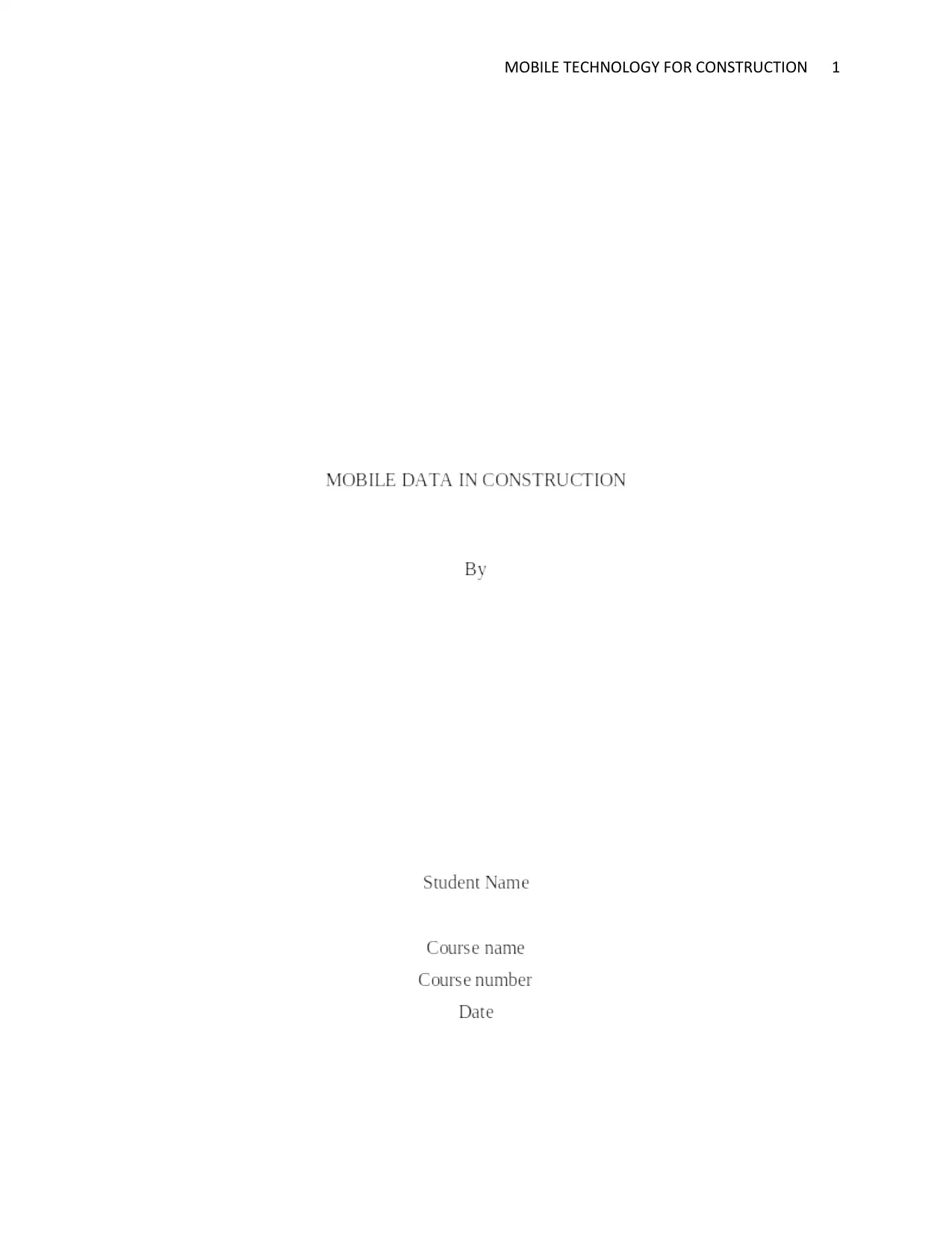
MOBILE TECHNOLOGY FOR CONSTRUCTION 1
Paraphrase This Document
Need a fresh take? Get an instant paraphrase of this document with our AI Paraphraser
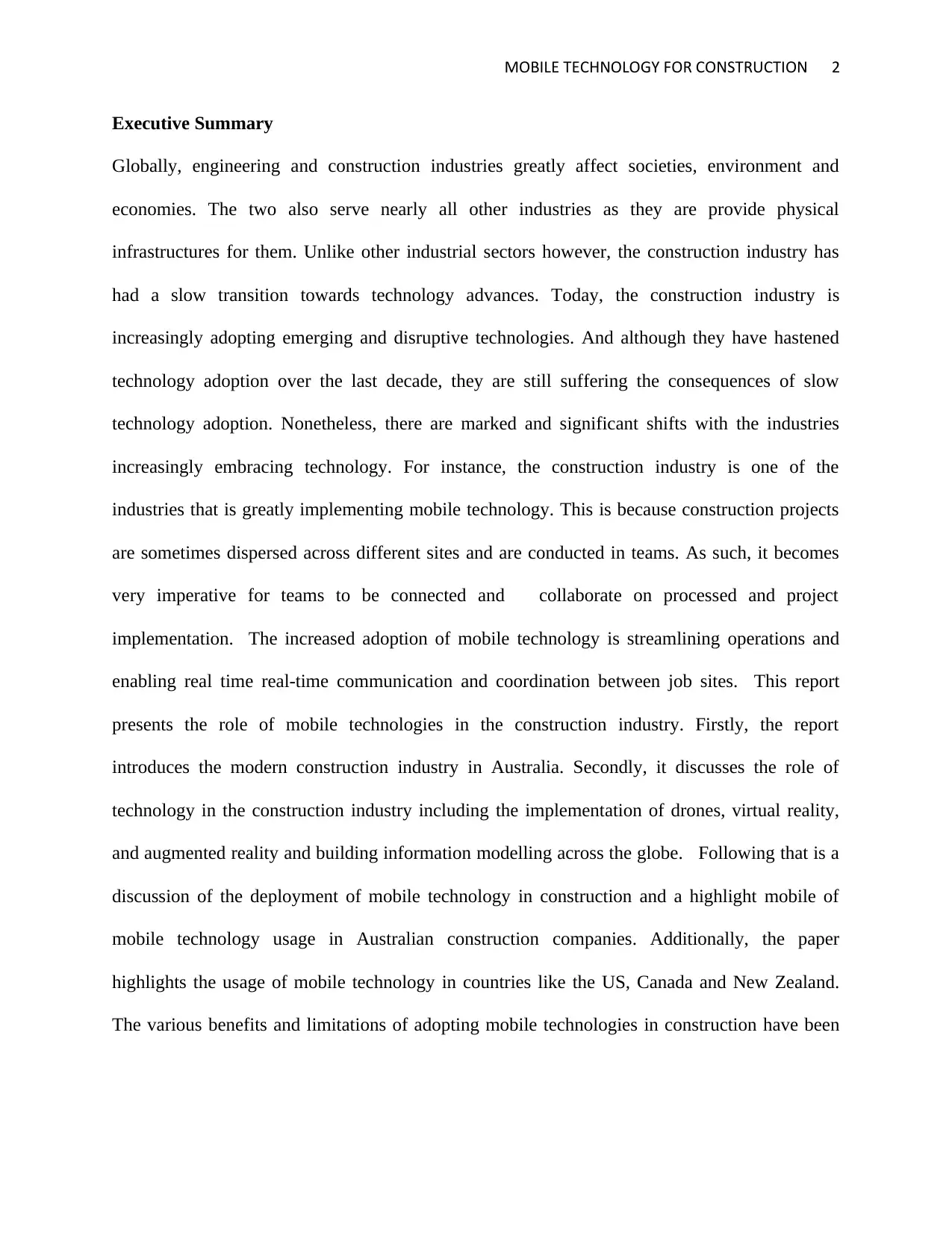
MOBILE TECHNOLOGY FOR CONSTRUCTION 2
Executive Summary
Globally, engineering and construction industries greatly affect societies, environment and
economies. The two also serve nearly all other industries as they are provide physical
infrastructures for them. Unlike other industrial sectors however, the construction industry has
had a slow transition towards technology advances. Today, the construction industry is
increasingly adopting emerging and disruptive technologies. And although they have hastened
technology adoption over the last decade, they are still suffering the consequences of slow
technology adoption. Nonetheless, there are marked and significant shifts with the industries
increasingly embracing technology. For instance, the construction industry is one of the
industries that is greatly implementing mobile technology. This is because construction projects
are sometimes dispersed across different sites and are conducted in teams. As such, it becomes
very imperative for teams to be connected and collaborate on processed and project
implementation. The increased adoption of mobile technology is streamlining operations and
enabling real time real-time communication and coordination between job sites. This report
presents the role of mobile technologies in the construction industry. Firstly, the report
introduces the modern construction industry in Australia. Secondly, it discusses the role of
technology in the construction industry including the implementation of drones, virtual reality,
and augmented reality and building information modelling across the globe. Following that is a
discussion of the deployment of mobile technology in construction and a highlight mobile of
mobile technology usage in Australian construction companies. Additionally, the paper
highlights the usage of mobile technology in countries like the US, Canada and New Zealand.
The various benefits and limitations of adopting mobile technologies in construction have been
Executive Summary
Globally, engineering and construction industries greatly affect societies, environment and
economies. The two also serve nearly all other industries as they are provide physical
infrastructures for them. Unlike other industrial sectors however, the construction industry has
had a slow transition towards technology advances. Today, the construction industry is
increasingly adopting emerging and disruptive technologies. And although they have hastened
technology adoption over the last decade, they are still suffering the consequences of slow
technology adoption. Nonetheless, there are marked and significant shifts with the industries
increasingly embracing technology. For instance, the construction industry is one of the
industries that is greatly implementing mobile technology. This is because construction projects
are sometimes dispersed across different sites and are conducted in teams. As such, it becomes
very imperative for teams to be connected and collaborate on processed and project
implementation. The increased adoption of mobile technology is streamlining operations and
enabling real time real-time communication and coordination between job sites. This report
presents the role of mobile technologies in the construction industry. Firstly, the report
introduces the modern construction industry in Australia. Secondly, it discusses the role of
technology in the construction industry including the implementation of drones, virtual reality,
and augmented reality and building information modelling across the globe. Following that is a
discussion of the deployment of mobile technology in construction and a highlight mobile of
mobile technology usage in Australian construction companies. Additionally, the paper
highlights the usage of mobile technology in countries like the US, Canada and New Zealand.
The various benefits and limitations of adopting mobile technologies in construction have been
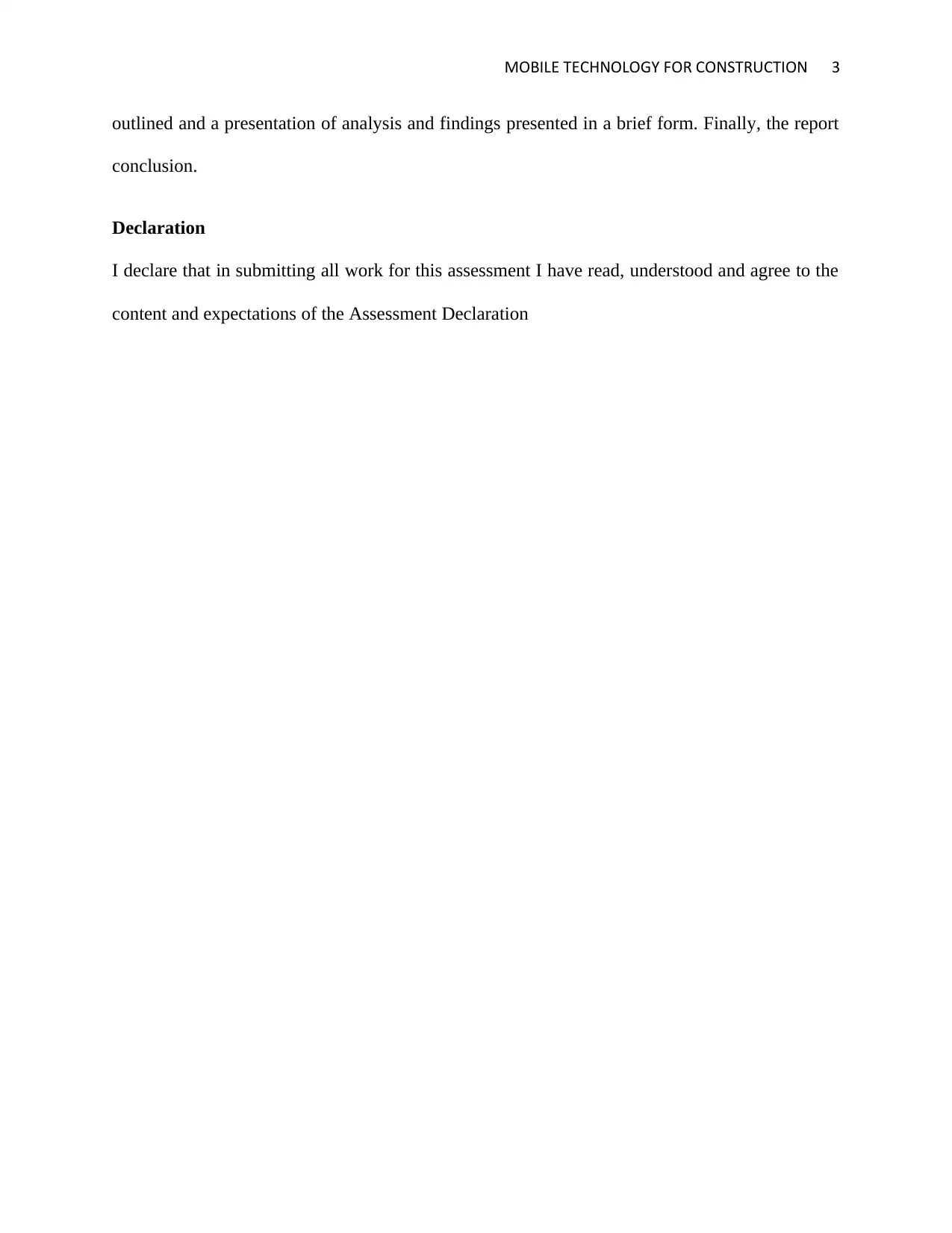
MOBILE TECHNOLOGY FOR CONSTRUCTION 3
outlined and a presentation of analysis and findings presented in a brief form. Finally, the report
conclusion.
Declaration
I declare that in submitting all work for this assessment I have read, understood and agree to the
content and expectations of the Assessment Declaration
outlined and a presentation of analysis and findings presented in a brief form. Finally, the report
conclusion.
Declaration
I declare that in submitting all work for this assessment I have read, understood and agree to the
content and expectations of the Assessment Declaration
⊘ This is a preview!⊘
Do you want full access?
Subscribe today to unlock all pages.

Trusted by 1+ million students worldwide
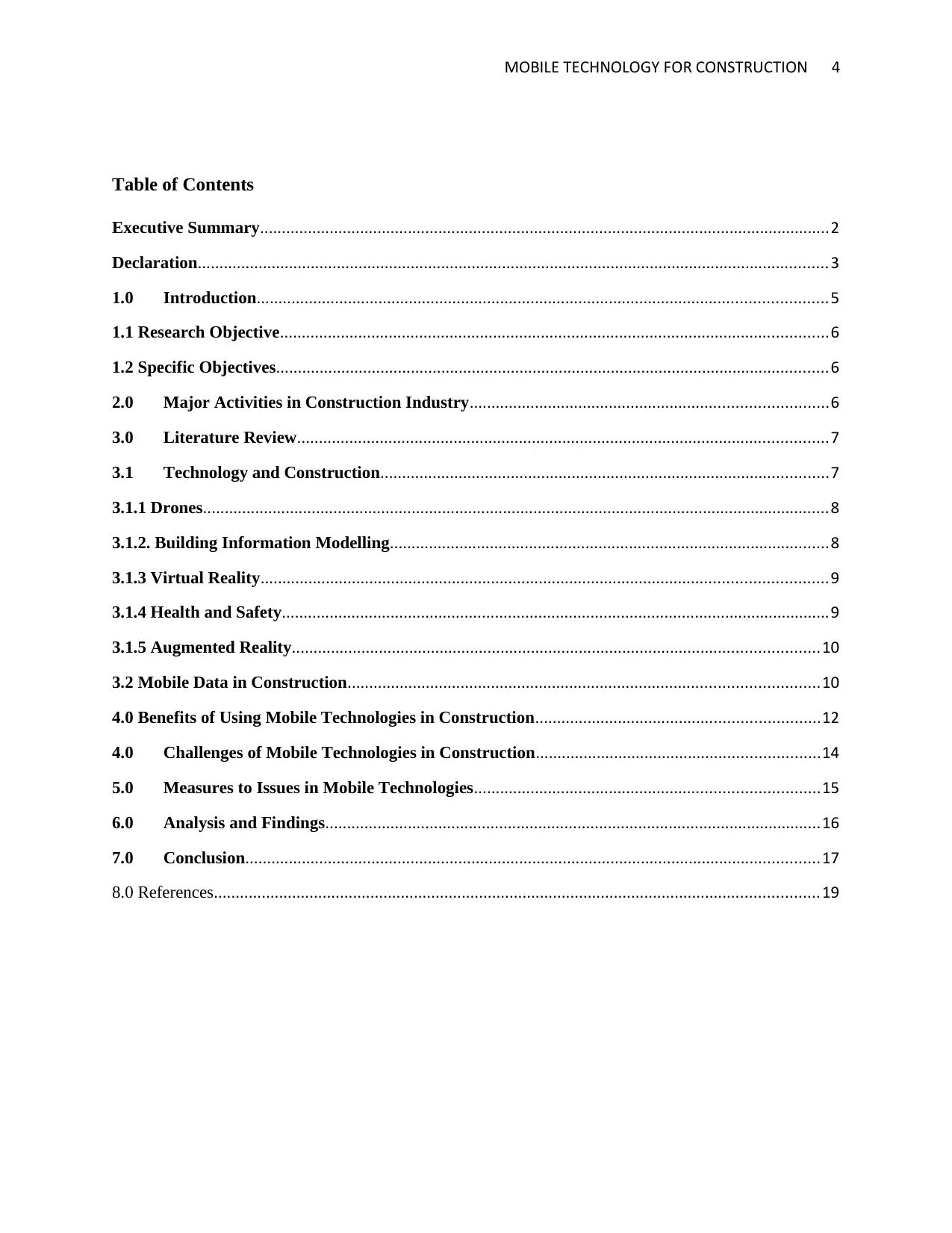
MOBILE TECHNOLOGY FOR CONSTRUCTION 4
Table of Contents
Executive Summary...................................................................................................................................2
Declaration.................................................................................................................................................3
1.0 Introduction...................................................................................................................................5
1.1 Research Objective..............................................................................................................................6
1.2 Specific Objectives...............................................................................................................................6
2.0 Major Activities in Construction Industry..................................................................................6
3.0 Literature Review..........................................................................................................................7
3.1 Technology and Construction.......................................................................................................7
3.1.1 Drones................................................................................................................................................8
3.1.2. Building Information Modelling.....................................................................................................8
3.1.3 Virtual Reality..................................................................................................................................9
3.1.4 Health and Safety..............................................................................................................................9
3.1.5 Augmented Reality.........................................................................................................................10
3.2 Mobile Data in Construction............................................................................................................10
4.0 Benefits of Using Mobile Technologies in Construction.................................................................12
4.0 Challenges of Mobile Technologies in Construction.................................................................14
5.0 Measures to Issues in Mobile Technologies...............................................................................15
6.0 Analysis and Findings..................................................................................................................16
7.0 Conclusion....................................................................................................................................17
8.0 References...........................................................................................................................................19
Table of Contents
Executive Summary...................................................................................................................................2
Declaration.................................................................................................................................................3
1.0 Introduction...................................................................................................................................5
1.1 Research Objective..............................................................................................................................6
1.2 Specific Objectives...............................................................................................................................6
2.0 Major Activities in Construction Industry..................................................................................6
3.0 Literature Review..........................................................................................................................7
3.1 Technology and Construction.......................................................................................................7
3.1.1 Drones................................................................................................................................................8
3.1.2. Building Information Modelling.....................................................................................................8
3.1.3 Virtual Reality..................................................................................................................................9
3.1.4 Health and Safety..............................................................................................................................9
3.1.5 Augmented Reality.........................................................................................................................10
3.2 Mobile Data in Construction............................................................................................................10
4.0 Benefits of Using Mobile Technologies in Construction.................................................................12
4.0 Challenges of Mobile Technologies in Construction.................................................................14
5.0 Measures to Issues in Mobile Technologies...............................................................................15
6.0 Analysis and Findings..................................................................................................................16
7.0 Conclusion....................................................................................................................................17
8.0 References...........................................................................................................................................19
Paraphrase This Document
Need a fresh take? Get an instant paraphrase of this document with our AI Paraphraser
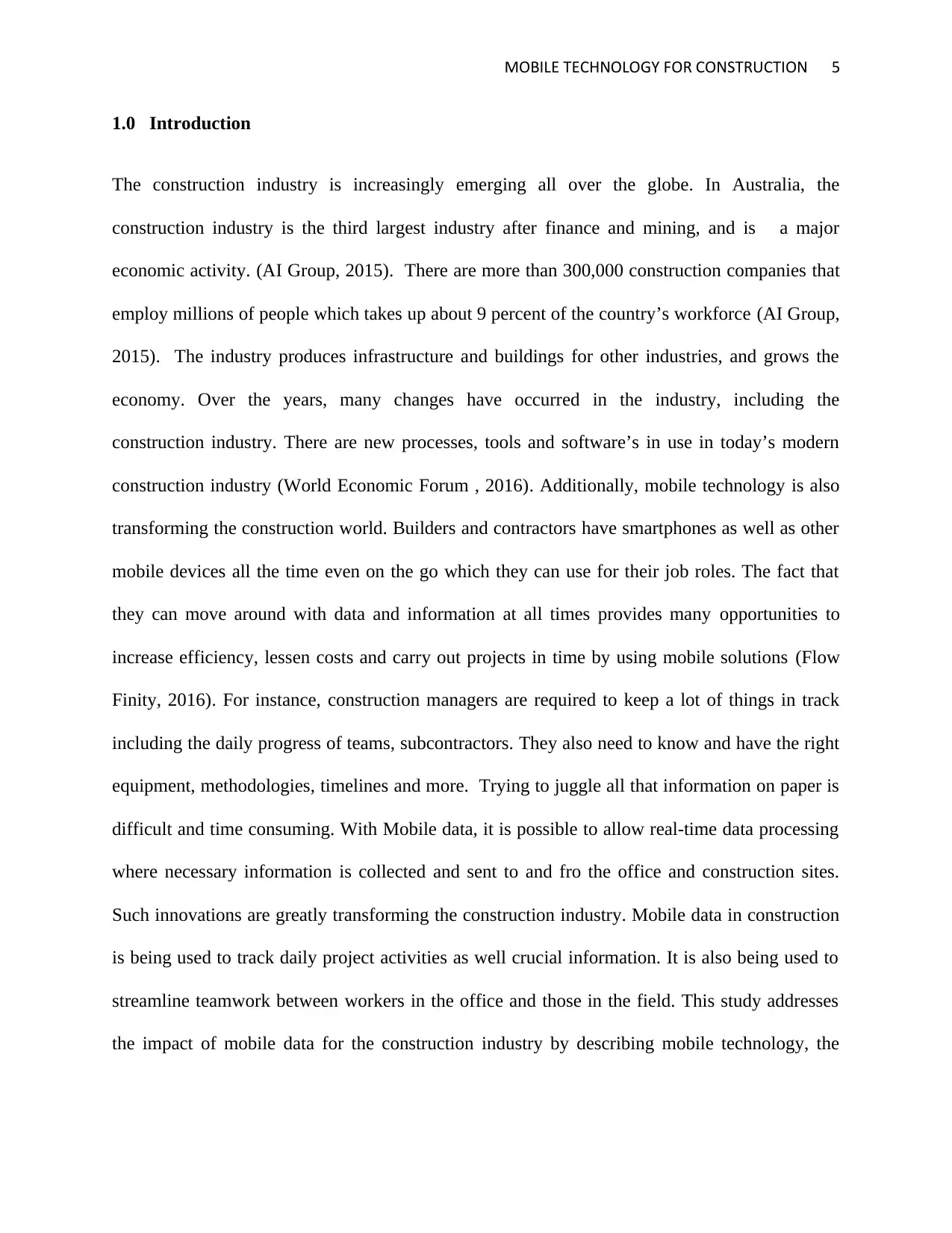
MOBILE TECHNOLOGY FOR CONSTRUCTION 5
1.0 Introduction
The construction industry is increasingly emerging all over the globe. In Australia, the
construction industry is the third largest industry after finance and mining, and is a major
economic activity. (AI Group, 2015). There are more than 300,000 construction companies that
employ millions of people which takes up about 9 percent of the country’s workforce (AI Group,
2015). The industry produces infrastructure and buildings for other industries, and grows the
economy. Over the years, many changes have occurred in the industry, including the
construction industry. There are new processes, tools and software’s in use in today’s modern
construction industry (World Economic Forum , 2016). Additionally, mobile technology is also
transforming the construction world. Builders and contractors have smartphones as well as other
mobile devices all the time even on the go which they can use for their job roles. The fact that
they can move around with data and information at all times provides many opportunities to
increase efficiency, lessen costs and carry out projects in time by using mobile solutions (Flow
Finity, 2016). For instance, construction managers are required to keep a lot of things in track
including the daily progress of teams, subcontractors. They also need to know and have the right
equipment, methodologies, timelines and more. Trying to juggle all that information on paper is
difficult and time consuming. With Mobile data, it is possible to allow real-time data processing
where necessary information is collected and sent to and fro the office and construction sites.
Such innovations are greatly transforming the construction industry. Mobile data in construction
is being used to track daily project activities as well crucial information. It is also being used to
streamline teamwork between workers in the office and those in the field. This study addresses
the impact of mobile data for the construction industry by describing mobile technology, the
1.0 Introduction
The construction industry is increasingly emerging all over the globe. In Australia, the
construction industry is the third largest industry after finance and mining, and is a major
economic activity. (AI Group, 2015). There are more than 300,000 construction companies that
employ millions of people which takes up about 9 percent of the country’s workforce (AI Group,
2015). The industry produces infrastructure and buildings for other industries, and grows the
economy. Over the years, many changes have occurred in the industry, including the
construction industry. There are new processes, tools and software’s in use in today’s modern
construction industry (World Economic Forum , 2016). Additionally, mobile technology is also
transforming the construction world. Builders and contractors have smartphones as well as other
mobile devices all the time even on the go which they can use for their job roles. The fact that
they can move around with data and information at all times provides many opportunities to
increase efficiency, lessen costs and carry out projects in time by using mobile solutions (Flow
Finity, 2016). For instance, construction managers are required to keep a lot of things in track
including the daily progress of teams, subcontractors. They also need to know and have the right
equipment, methodologies, timelines and more. Trying to juggle all that information on paper is
difficult and time consuming. With Mobile data, it is possible to allow real-time data processing
where necessary information is collected and sent to and fro the office and construction sites.
Such innovations are greatly transforming the construction industry. Mobile data in construction
is being used to track daily project activities as well crucial information. It is also being used to
streamline teamwork between workers in the office and those in the field. This study addresses
the impact of mobile data for the construction industry by describing mobile technology, the
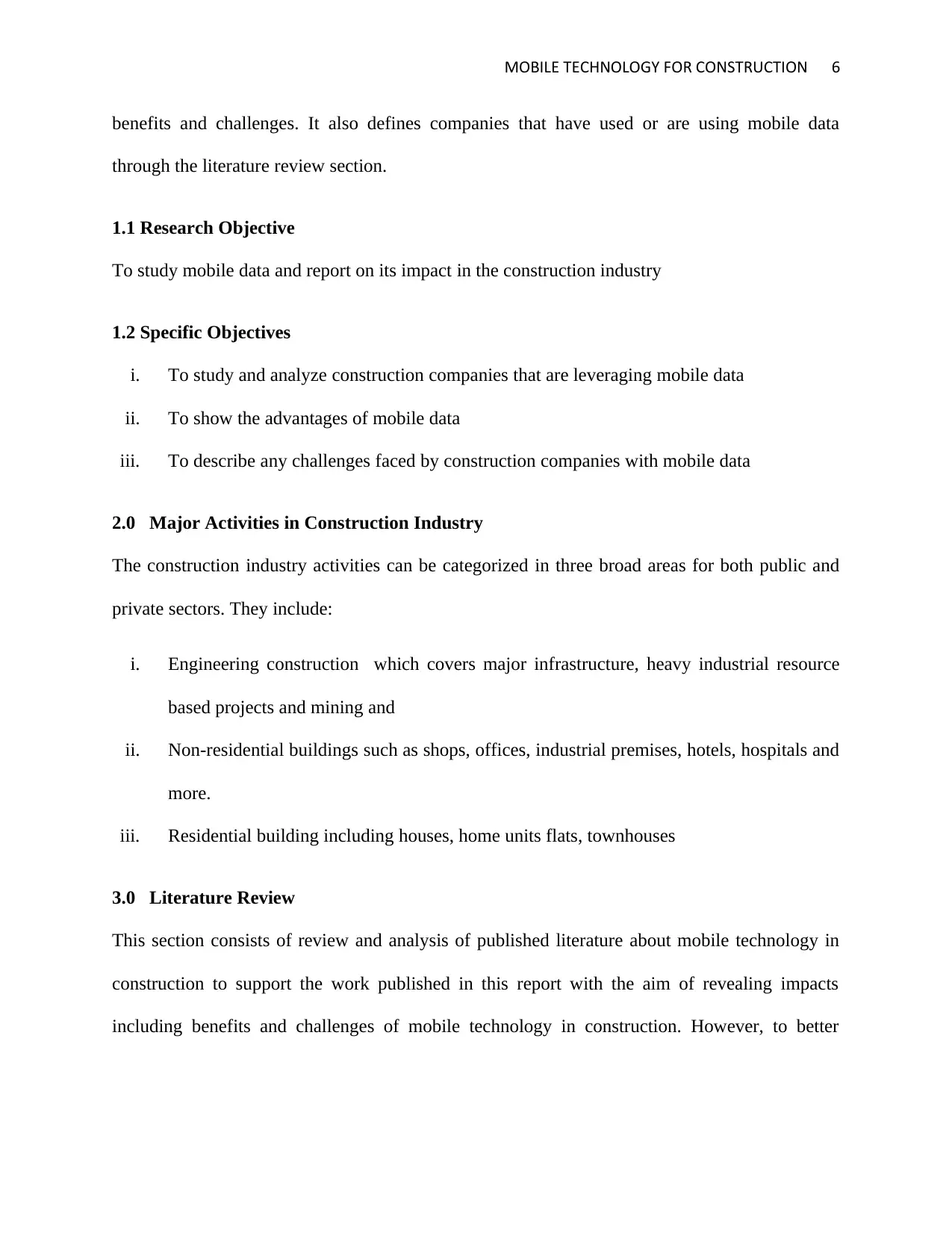
MOBILE TECHNOLOGY FOR CONSTRUCTION 6
benefits and challenges. It also defines companies that have used or are using mobile data
through the literature review section.
1.1 Research Objective
To study mobile data and report on its impact in the construction industry
1.2 Specific Objectives
i. To study and analyze construction companies that are leveraging mobile data
ii. To show the advantages of mobile data
iii. To describe any challenges faced by construction companies with mobile data
2.0 Major Activities in Construction Industry
The construction industry activities can be categorized in three broad areas for both public and
private sectors. They include:
i. Engineering construction which covers major infrastructure, heavy industrial resource
based projects and mining and
ii. Non-residential buildings such as shops, offices, industrial premises, hotels, hospitals and
more.
iii. Residential building including houses, home units flats, townhouses
3.0 Literature Review
This section consists of review and analysis of published literature about mobile technology in
construction to support the work published in this report with the aim of revealing impacts
including benefits and challenges of mobile technology in construction. However, to better
benefits and challenges. It also defines companies that have used or are using mobile data
through the literature review section.
1.1 Research Objective
To study mobile data and report on its impact in the construction industry
1.2 Specific Objectives
i. To study and analyze construction companies that are leveraging mobile data
ii. To show the advantages of mobile data
iii. To describe any challenges faced by construction companies with mobile data
2.0 Major Activities in Construction Industry
The construction industry activities can be categorized in three broad areas for both public and
private sectors. They include:
i. Engineering construction which covers major infrastructure, heavy industrial resource
based projects and mining and
ii. Non-residential buildings such as shops, offices, industrial premises, hotels, hospitals and
more.
iii. Residential building including houses, home units flats, townhouses
3.0 Literature Review
This section consists of review and analysis of published literature about mobile technology in
construction to support the work published in this report with the aim of revealing impacts
including benefits and challenges of mobile technology in construction. However, to better
⊘ This is a preview!⊘
Do you want full access?
Subscribe today to unlock all pages.

Trusted by 1+ million students worldwide
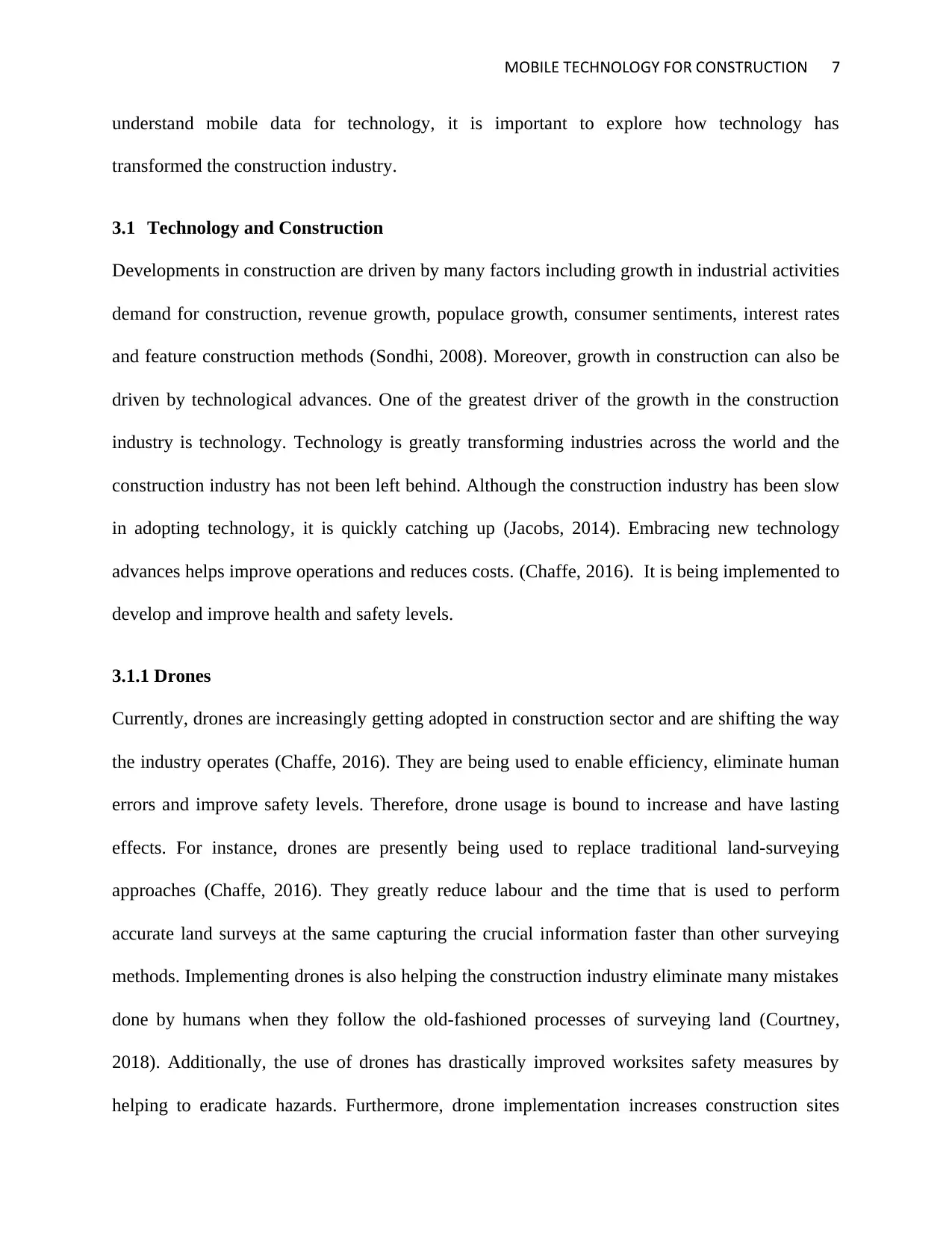
MOBILE TECHNOLOGY FOR CONSTRUCTION 7
understand mobile data for technology, it is important to explore how technology has
transformed the construction industry.
3.1 Technology and Construction
Developments in construction are driven by many factors including growth in industrial activities
demand for construction, revenue growth, populace growth, consumer sentiments, interest rates
and feature construction methods (Sondhi, 2008). Moreover, growth in construction can also be
driven by technological advances. One of the greatest driver of the growth in the construction
industry is technology. Technology is greatly transforming industries across the world and the
construction industry has not been left behind. Although the construction industry has been slow
in adopting technology, it is quickly catching up (Jacobs, 2014). Embracing new technology
advances helps improve operations and reduces costs. (Chaffe, 2016). It is being implemented to
develop and improve health and safety levels.
3.1.1 Drones
Currently, drones are increasingly getting adopted in construction sector and are shifting the way
the industry operates (Chaffe, 2016). They are being used to enable efficiency, eliminate human
errors and improve safety levels. Therefore, drone usage is bound to increase and have lasting
effects. For instance, drones are presently being used to replace traditional land-surveying
approaches (Chaffe, 2016). They greatly reduce labour and the time that is used to perform
accurate land surveys at the same capturing the crucial information faster than other surveying
methods. Implementing drones is also helping the construction industry eliminate many mistakes
done by humans when they follow the old-fashioned processes of surveying land (Courtney,
2018). Additionally, the use of drones has drastically improved worksites safety measures by
helping to eradicate hazards. Furthermore, drone implementation increases construction sites
understand mobile data for technology, it is important to explore how technology has
transformed the construction industry.
3.1 Technology and Construction
Developments in construction are driven by many factors including growth in industrial activities
demand for construction, revenue growth, populace growth, consumer sentiments, interest rates
and feature construction methods (Sondhi, 2008). Moreover, growth in construction can also be
driven by technological advances. One of the greatest driver of the growth in the construction
industry is technology. Technology is greatly transforming industries across the world and the
construction industry has not been left behind. Although the construction industry has been slow
in adopting technology, it is quickly catching up (Jacobs, 2014). Embracing new technology
advances helps improve operations and reduces costs. (Chaffe, 2016). It is being implemented to
develop and improve health and safety levels.
3.1.1 Drones
Currently, drones are increasingly getting adopted in construction sector and are shifting the way
the industry operates (Chaffe, 2016). They are being used to enable efficiency, eliminate human
errors and improve safety levels. Therefore, drone usage is bound to increase and have lasting
effects. For instance, drones are presently being used to replace traditional land-surveying
approaches (Chaffe, 2016). They greatly reduce labour and the time that is used to perform
accurate land surveys at the same capturing the crucial information faster than other surveying
methods. Implementing drones is also helping the construction industry eliminate many mistakes
done by humans when they follow the old-fashioned processes of surveying land (Courtney,
2018). Additionally, the use of drones has drastically improved worksites safety measures by
helping to eradicate hazards. Furthermore, drone implementation increases construction sites
Paraphrase This Document
Need a fresh take? Get an instant paraphrase of this document with our AI Paraphraser
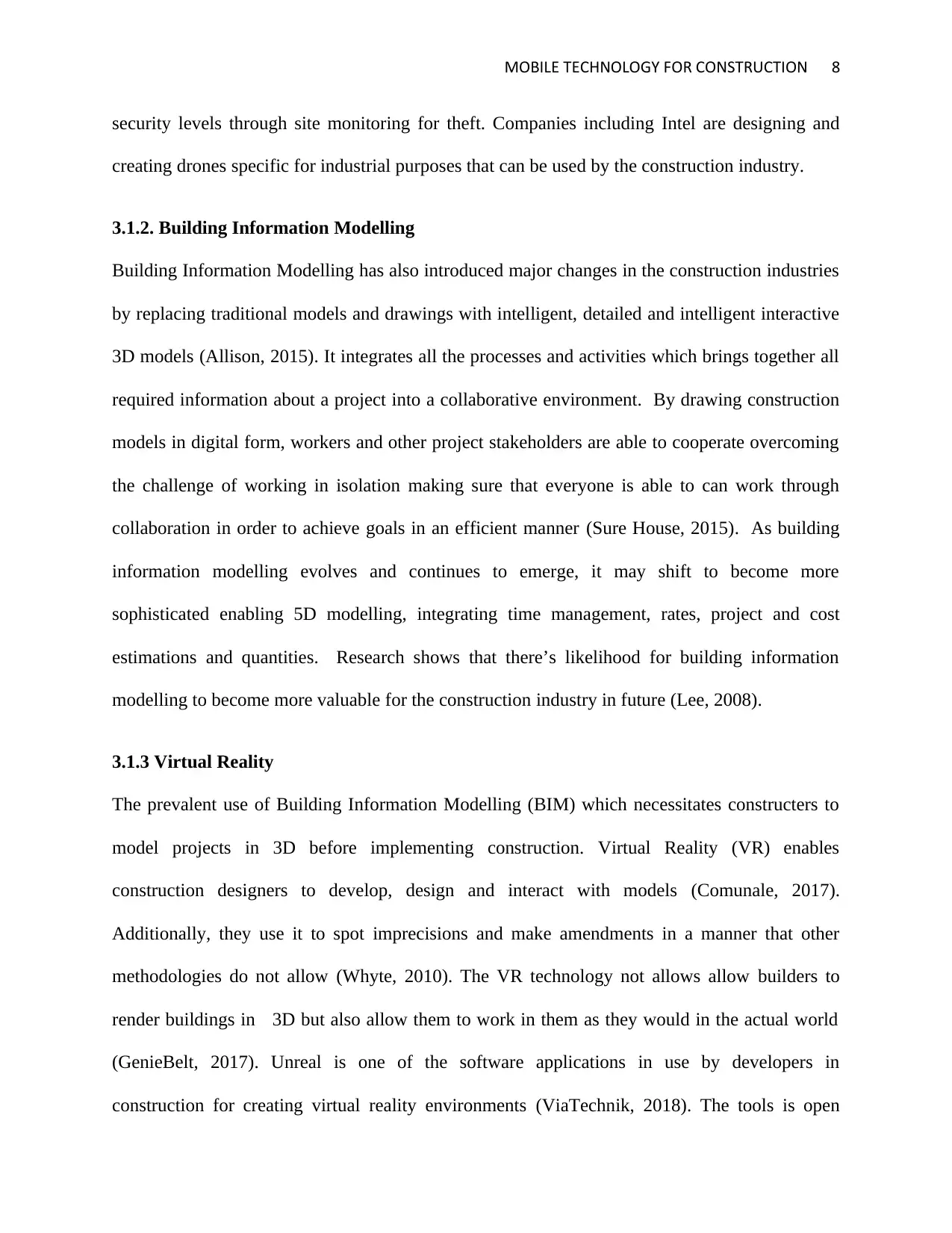
MOBILE TECHNOLOGY FOR CONSTRUCTION 8
security levels through site monitoring for theft. Companies including Intel are designing and
creating drones specific for industrial purposes that can be used by the construction industry.
3.1.2. Building Information Modelling
Building Information Modelling has also introduced major changes in the construction industries
by replacing traditional models and drawings with intelligent, detailed and intelligent interactive
3D models (Allison, 2015). It integrates all the processes and activities which brings together all
required information about a project into a collaborative environment. By drawing construction
models in digital form, workers and other project stakeholders are able to cooperate overcoming
the challenge of working in isolation making sure that everyone is able to can work through
collaboration in order to achieve goals in an efficient manner (Sure House, 2015). As building
information modelling evolves and continues to emerge, it may shift to become more
sophisticated enabling 5D modelling, integrating time management, rates, project and cost
estimations and quantities. Research shows that there’s likelihood for building information
modelling to become more valuable for the construction industry in future (Lee, 2008).
3.1.3 Virtual Reality
The prevalent use of Building Information Modelling (BIM) which necessitates constructers to
model projects in 3D before implementing construction. Virtual Reality (VR) enables
construction designers to develop, design and interact with models (Comunale, 2017).
Additionally, they use it to spot imprecisions and make amendments in a manner that other
methodologies do not allow (Whyte, 2010). The VR technology not allows allow builders to
render buildings in 3D but also allow them to work in them as they would in the actual world
(GenieBelt, 2017). Unreal is one of the software applications in use by developers in
construction for creating virtual reality environments (ViaTechnik, 2018). The tools is open
security levels through site monitoring for theft. Companies including Intel are designing and
creating drones specific for industrial purposes that can be used by the construction industry.
3.1.2. Building Information Modelling
Building Information Modelling has also introduced major changes in the construction industries
by replacing traditional models and drawings with intelligent, detailed and intelligent interactive
3D models (Allison, 2015). It integrates all the processes and activities which brings together all
required information about a project into a collaborative environment. By drawing construction
models in digital form, workers and other project stakeholders are able to cooperate overcoming
the challenge of working in isolation making sure that everyone is able to can work through
collaboration in order to achieve goals in an efficient manner (Sure House, 2015). As building
information modelling evolves and continues to emerge, it may shift to become more
sophisticated enabling 5D modelling, integrating time management, rates, project and cost
estimations and quantities. Research shows that there’s likelihood for building information
modelling to become more valuable for the construction industry in future (Lee, 2008).
3.1.3 Virtual Reality
The prevalent use of Building Information Modelling (BIM) which necessitates constructers to
model projects in 3D before implementing construction. Virtual Reality (VR) enables
construction designers to develop, design and interact with models (Comunale, 2017).
Additionally, they use it to spot imprecisions and make amendments in a manner that other
methodologies do not allow (Whyte, 2010). The VR technology not allows allow builders to
render buildings in 3D but also allow them to work in them as they would in the actual world
(GenieBelt, 2017). Unreal is one of the software applications in use by developers in
construction for creating virtual reality environments (ViaTechnik, 2018). The tools is open
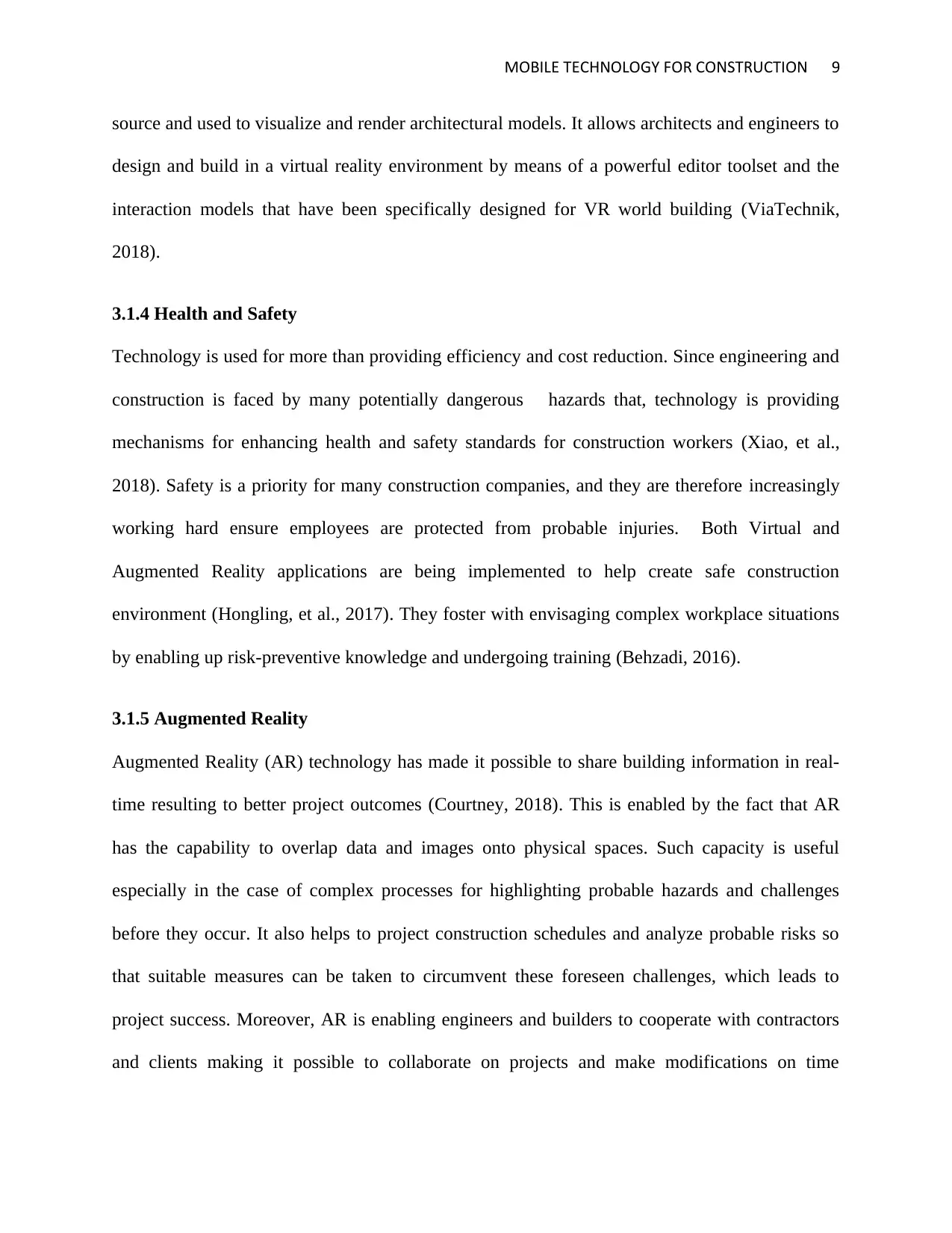
MOBILE TECHNOLOGY FOR CONSTRUCTION 9
source and used to visualize and render architectural models. It allows architects and engineers to
design and build in a virtual reality environment by means of a powerful editor toolset and the
interaction models that have been specifically designed for VR world building (ViaTechnik,
2018).
3.1.4 Health and Safety
Technology is used for more than providing efficiency and cost reduction. Since engineering and
construction is faced by many potentially dangerous hazards that, technology is providing
mechanisms for enhancing health and safety standards for construction workers (Xiao, et al.,
2018). Safety is a priority for many construction companies, and they are therefore increasingly
working hard ensure employees are protected from probable injuries. Both Virtual and
Augmented Reality applications are being implemented to help create safe construction
environment (Hongling, et al., 2017). They foster with envisaging complex workplace situations
by enabling up risk-preventive knowledge and undergoing training (Behzadi, 2016).
3.1.5 Augmented Reality
Augmented Reality (AR) technology has made it possible to share building information in real-
time resulting to better project outcomes (Courtney, 2018). This is enabled by the fact that AR
has the capability to overlap data and images onto physical spaces. Such capacity is useful
especially in the case of complex processes for highlighting probable hazards and challenges
before they occur. It also helps to project construction schedules and analyze probable risks so
that suitable measures can be taken to circumvent these foreseen challenges, which leads to
project success. Moreover, AR is enabling engineers and builders to cooperate with contractors
and clients making it possible to collaborate on projects and make modifications on time
source and used to visualize and render architectural models. It allows architects and engineers to
design and build in a virtual reality environment by means of a powerful editor toolset and the
interaction models that have been specifically designed for VR world building (ViaTechnik,
2018).
3.1.4 Health and Safety
Technology is used for more than providing efficiency and cost reduction. Since engineering and
construction is faced by many potentially dangerous hazards that, technology is providing
mechanisms for enhancing health and safety standards for construction workers (Xiao, et al.,
2018). Safety is a priority for many construction companies, and they are therefore increasingly
working hard ensure employees are protected from probable injuries. Both Virtual and
Augmented Reality applications are being implemented to help create safe construction
environment (Hongling, et al., 2017). They foster with envisaging complex workplace situations
by enabling up risk-preventive knowledge and undergoing training (Behzadi, 2016).
3.1.5 Augmented Reality
Augmented Reality (AR) technology has made it possible to share building information in real-
time resulting to better project outcomes (Courtney, 2018). This is enabled by the fact that AR
has the capability to overlap data and images onto physical spaces. Such capacity is useful
especially in the case of complex processes for highlighting probable hazards and challenges
before they occur. It also helps to project construction schedules and analyze probable risks so
that suitable measures can be taken to circumvent these foreseen challenges, which leads to
project success. Moreover, AR is enabling engineers and builders to cooperate with contractors
and clients making it possible to collaborate on projects and make modifications on time
⊘ This is a preview!⊘
Do you want full access?
Subscribe today to unlock all pages.

Trusted by 1+ million students worldwide
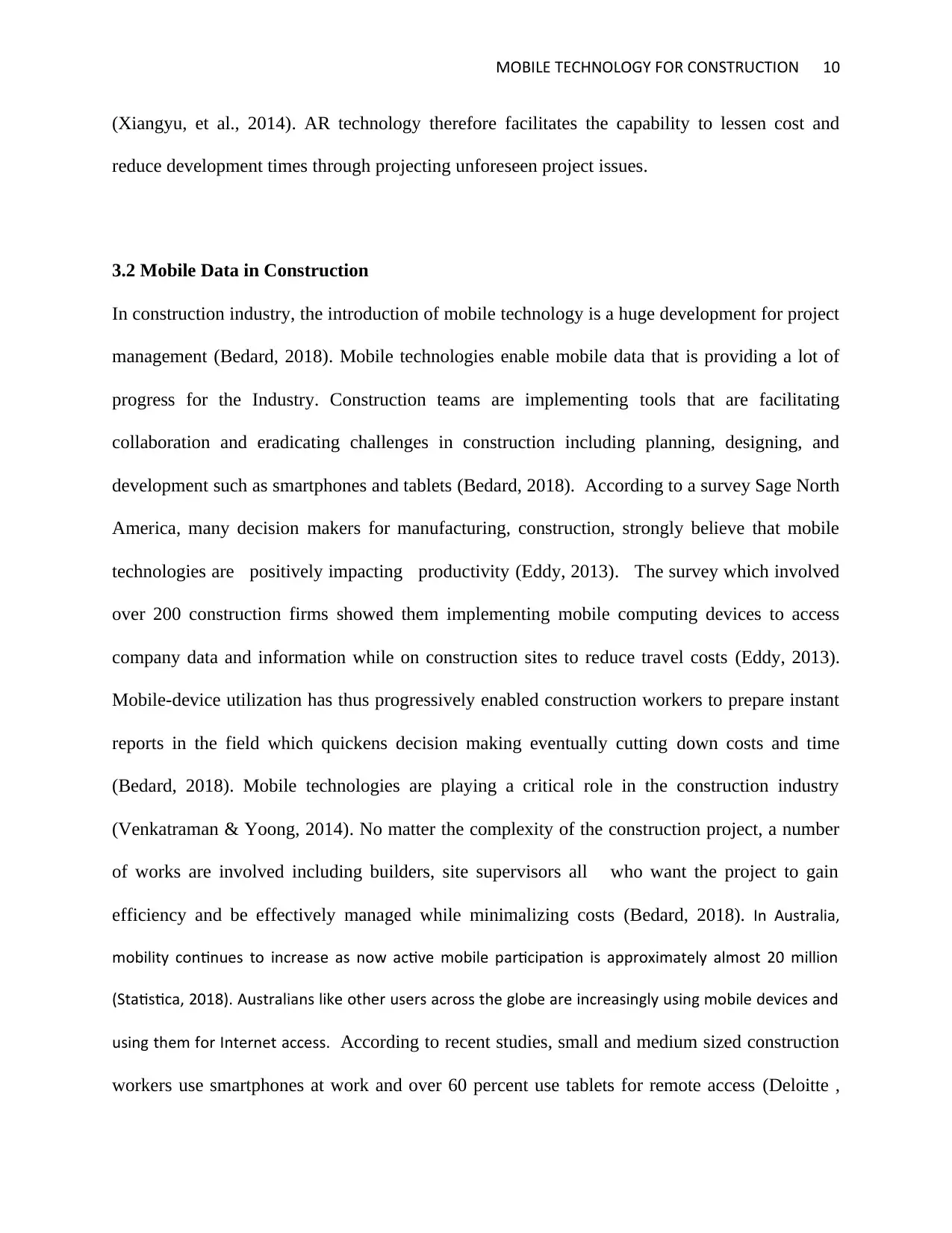
MOBILE TECHNOLOGY FOR CONSTRUCTION 10
(Xiangyu, et al., 2014). AR technology therefore facilitates the capability to lessen cost and
reduce development times through projecting unforeseen project issues.
3.2 Mobile Data in Construction
In construction industry, the introduction of mobile technology is a huge development for project
management (Bedard, 2018). Mobile technologies enable mobile data that is providing a lot of
progress for the Industry. Construction teams are implementing tools that are facilitating
collaboration and eradicating challenges in construction including planning, designing, and
development such as smartphones and tablets (Bedard, 2018). According to a survey Sage North
America, many decision makers for manufacturing, construction, strongly believe that mobile
technologies are positively impacting productivity (Eddy, 2013). The survey which involved
over 200 construction firms showed them implementing mobile computing devices to access
company data and information while on construction sites to reduce travel costs (Eddy, 2013).
Mobile-device utilization has thus progressively enabled construction workers to prepare instant
reports in the field which quickens decision making eventually cutting down costs and time
(Bedard, 2018). Mobile technologies are playing a critical role in the construction industry
(Venkatraman & Yoong, 2014). No matter the complexity of the construction project, a number
of works are involved including builders, site supervisors all who want the project to gain
efficiency and be effectively managed while minimalizing costs (Bedard, 2018). In Australia,
mobility continues to increase as now active mobile participation is approximately almost 20 million
(Statistica, 2018). Australians like other users across the globe are increasingly using mobile devices and
using them for Internet access. According to recent studies, small and medium sized construction
workers use smartphones at work and over 60 percent use tablets for remote access (Deloitte ,
(Xiangyu, et al., 2014). AR technology therefore facilitates the capability to lessen cost and
reduce development times through projecting unforeseen project issues.
3.2 Mobile Data in Construction
In construction industry, the introduction of mobile technology is a huge development for project
management (Bedard, 2018). Mobile technologies enable mobile data that is providing a lot of
progress for the Industry. Construction teams are implementing tools that are facilitating
collaboration and eradicating challenges in construction including planning, designing, and
development such as smartphones and tablets (Bedard, 2018). According to a survey Sage North
America, many decision makers for manufacturing, construction, strongly believe that mobile
technologies are positively impacting productivity (Eddy, 2013). The survey which involved
over 200 construction firms showed them implementing mobile computing devices to access
company data and information while on construction sites to reduce travel costs (Eddy, 2013).
Mobile-device utilization has thus progressively enabled construction workers to prepare instant
reports in the field which quickens decision making eventually cutting down costs and time
(Bedard, 2018). Mobile technologies are playing a critical role in the construction industry
(Venkatraman & Yoong, 2014). No matter the complexity of the construction project, a number
of works are involved including builders, site supervisors all who want the project to gain
efficiency and be effectively managed while minimalizing costs (Bedard, 2018). In Australia,
mobility continues to increase as now active mobile participation is approximately almost 20 million
(Statistica, 2018). Australians like other users across the globe are increasingly using mobile devices and
using them for Internet access. According to recent studies, small and medium sized construction
workers use smartphones at work and over 60 percent use tablets for remote access (Deloitte ,
Paraphrase This Document
Need a fresh take? Get an instant paraphrase of this document with our AI Paraphraser
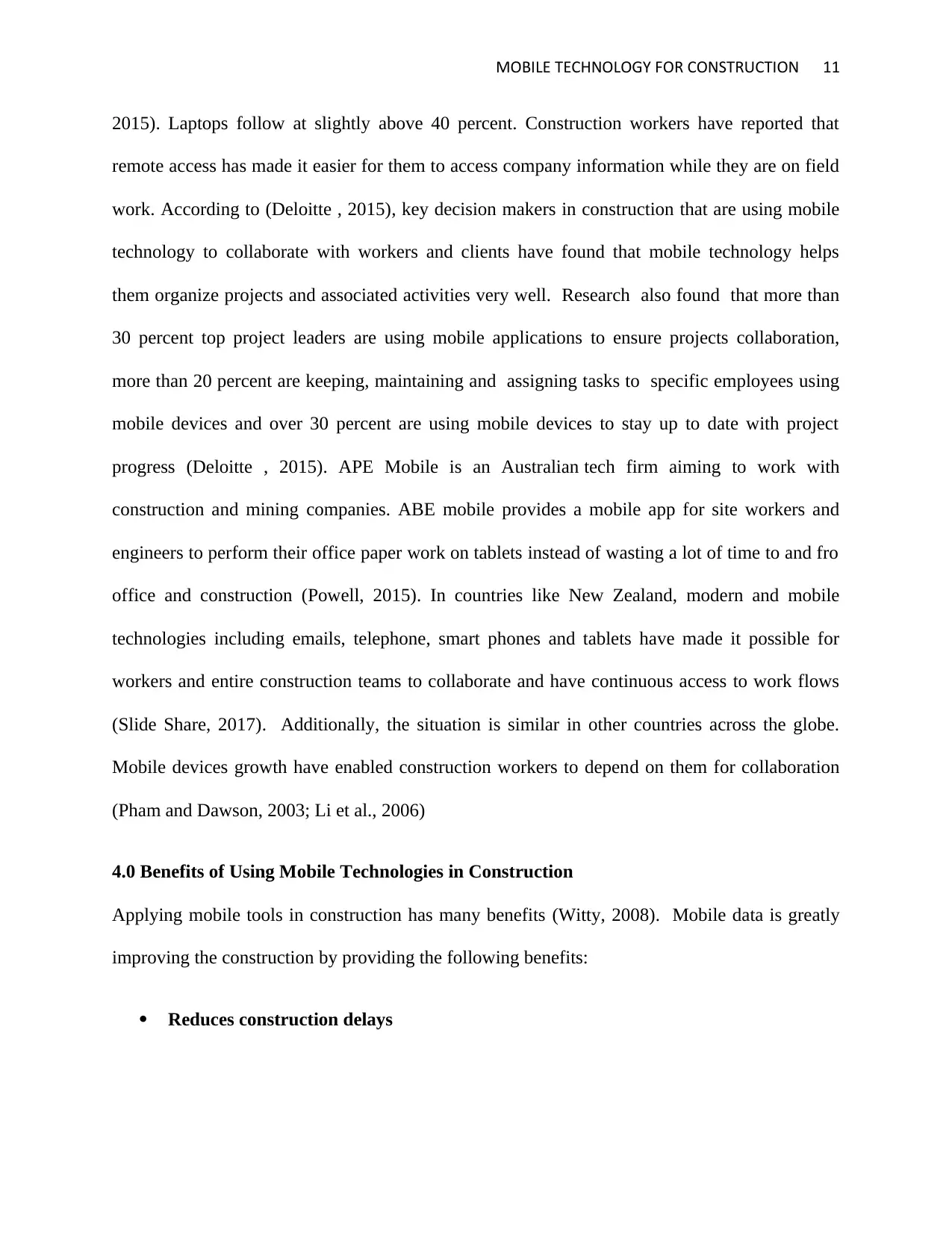
MOBILE TECHNOLOGY FOR CONSTRUCTION 11
2015). Laptops follow at slightly above 40 percent. Construction workers have reported that
remote access has made it easier for them to access company information while they are on field
work. According to (Deloitte , 2015), key decision makers in construction that are using mobile
technology to collaborate with workers and clients have found that mobile technology helps
them organize projects and associated activities very well. Research also found that more than
30 percent top project leaders are using mobile applications to ensure projects collaboration,
more than 20 percent are keeping, maintaining and assigning tasks to specific employees using
mobile devices and over 30 percent are using mobile devices to stay up to date with project
progress (Deloitte , 2015). APE Mobile is an Australian tech firm aiming to work with
construction and mining companies. ABE mobile provides a mobile app for site workers and
engineers to perform their office paper work on tablets instead of wasting a lot of time to and fro
office and construction (Powell, 2015). In countries like New Zealand, modern and mobile
technologies including emails, telephone, smart phones and tablets have made it possible for
workers and entire construction teams to collaborate and have continuous access to work flows
(Slide Share, 2017). Additionally, the situation is similar in other countries across the globe.
Mobile devices growth have enabled construction workers to depend on them for collaboration
(Pham and Dawson, 2003; Li et al., 2006)
4.0 Benefits of Using Mobile Technologies in Construction
Applying mobile tools in construction has many benefits (Witty, 2008). Mobile data is greatly
improving the construction by providing the following benefits:
Reduces construction delays
2015). Laptops follow at slightly above 40 percent. Construction workers have reported that
remote access has made it easier for them to access company information while they are on field
work. According to (Deloitte , 2015), key decision makers in construction that are using mobile
technology to collaborate with workers and clients have found that mobile technology helps
them organize projects and associated activities very well. Research also found that more than
30 percent top project leaders are using mobile applications to ensure projects collaboration,
more than 20 percent are keeping, maintaining and assigning tasks to specific employees using
mobile devices and over 30 percent are using mobile devices to stay up to date with project
progress (Deloitte , 2015). APE Mobile is an Australian tech firm aiming to work with
construction and mining companies. ABE mobile provides a mobile app for site workers and
engineers to perform their office paper work on tablets instead of wasting a lot of time to and fro
office and construction (Powell, 2015). In countries like New Zealand, modern and mobile
technologies including emails, telephone, smart phones and tablets have made it possible for
workers and entire construction teams to collaborate and have continuous access to work flows
(Slide Share, 2017). Additionally, the situation is similar in other countries across the globe.
Mobile devices growth have enabled construction workers to depend on them for collaboration
(Pham and Dawson, 2003; Li et al., 2006)
4.0 Benefits of Using Mobile Technologies in Construction
Applying mobile tools in construction has many benefits (Witty, 2008). Mobile data is greatly
improving the construction by providing the following benefits:
Reduces construction delays
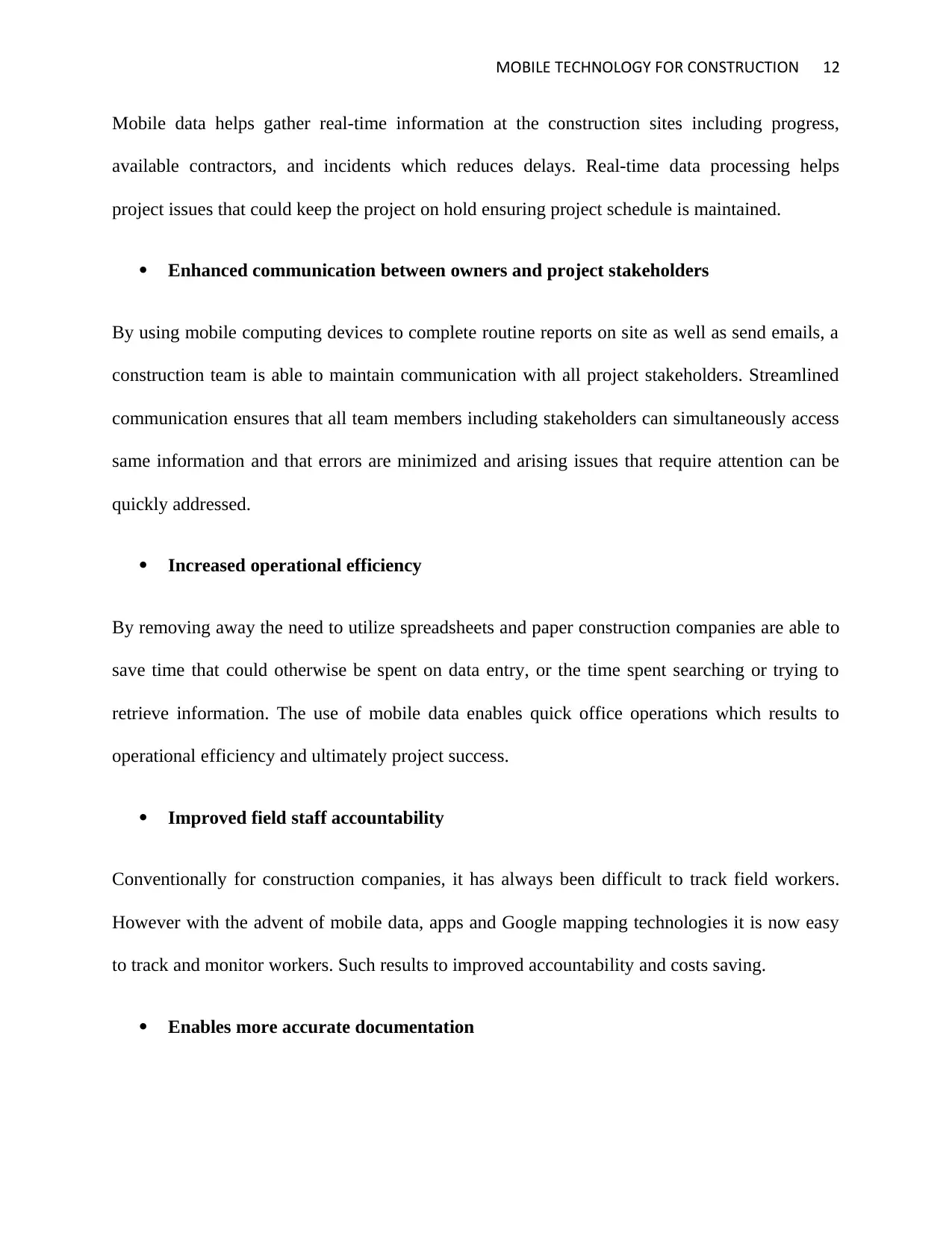
MOBILE TECHNOLOGY FOR CONSTRUCTION 12
Mobile data helps gather real-time information at the construction sites including progress,
available contractors, and incidents which reduces delays. Real-time data processing helps
project issues that could keep the project on hold ensuring project schedule is maintained.
Enhanced communication between owners and project stakeholders
By using mobile computing devices to complete routine reports on site as well as send emails, a
construction team is able to maintain communication with all project stakeholders. Streamlined
communication ensures that all team members including stakeholders can simultaneously access
same information and that errors are minimized and arising issues that require attention can be
quickly addressed.
Increased operational efficiency
By removing away the need to utilize spreadsheets and paper construction companies are able to
save time that could otherwise be spent on data entry, or the time spent searching or trying to
retrieve information. The use of mobile data enables quick office operations which results to
operational efficiency and ultimately project success.
Improved field staff accountability
Conventionally for construction companies, it has always been difficult to track field workers.
However with the advent of mobile data, apps and Google mapping technologies it is now easy
to track and monitor workers. Such results to improved accountability and costs saving.
Enables more accurate documentation
Mobile data helps gather real-time information at the construction sites including progress,
available contractors, and incidents which reduces delays. Real-time data processing helps
project issues that could keep the project on hold ensuring project schedule is maintained.
Enhanced communication between owners and project stakeholders
By using mobile computing devices to complete routine reports on site as well as send emails, a
construction team is able to maintain communication with all project stakeholders. Streamlined
communication ensures that all team members including stakeholders can simultaneously access
same information and that errors are minimized and arising issues that require attention can be
quickly addressed.
Increased operational efficiency
By removing away the need to utilize spreadsheets and paper construction companies are able to
save time that could otherwise be spent on data entry, or the time spent searching or trying to
retrieve information. The use of mobile data enables quick office operations which results to
operational efficiency and ultimately project success.
Improved field staff accountability
Conventionally for construction companies, it has always been difficult to track field workers.
However with the advent of mobile data, apps and Google mapping technologies it is now easy
to track and monitor workers. Such results to improved accountability and costs saving.
Enables more accurate documentation
⊘ This is a preview!⊘
Do you want full access?
Subscribe today to unlock all pages.

Trusted by 1+ million students worldwide
1 out of 21
Your All-in-One AI-Powered Toolkit for Academic Success.
+13062052269
info@desklib.com
Available 24*7 on WhatsApp / Email
![[object Object]](/_next/static/media/star-bottom.7253800d.svg)
Unlock your academic potential
Copyright © 2020–2025 A2Z Services. All Rights Reserved. Developed and managed by ZUCOL.

